TWO-PHASE TREATMENT
WHAT IS THE REASON OF TWO-PHASE ORTHODONTIC TREATMENT?
This type of treatment is probably the most misunderstood part of orthodontic treatment. Two-phase orthodontic treatment is a specialized process that combines tooth straightening with structural facial and skeletal changes, usually done around the age of 7 or 8. Mostchildren do not need Phase 1 treatment, but for those that do, this treatment is very important. The primary purpose of two-phase treatment is to reduce the severity of orthodontic problems at an early age and allow for improved natural growth and dental development.These problems include crossbites, harmful habits, severe flaring or rotations, jaw misalignment, loss of primary teeth, damage to the gum tissues, problems with eruption, and crowding problems. It is not designed to prevent full treatment later but to simplify it and prevent other more permanent damage from occurring to the teeth or tissues.
WHAT IF TREATMENT IS PUT OFF?
Putting off treatment can result in a need for more invasive treatment later in life that may not completely fix your child's smile. Early treatment, in the right case, is most effective way for achieving lasting results. One important note is that dental damage is not reversible. It can only be fixed with more dental treatment that can add considerably more time and cost later. That is why prevention is such a big part of any dental treatment.
PHASE ONE TREATMENT
The goal of Phase 1 treatment is to help the jaws develop in a way that will accommodate all of the permanent teeth and improve the way the upper and lower jaws fit together. Children often exhibit early signs of jaw problems as they grow and develop. An upper jaw that is growing too much or is too narrow can be recognized at an early age. If children over the age of six are found to have this jaw discrepancy, they are candidates for early orthodontic treatment. Also, if children around the age of eight have crowded front teeth, early treatment can often prevent the need to extract permanent teeth later.
There are many different types of Phase 1 that are done depending on the type of problems. Some involve expansion of the upper jaw. In cases where primary teeth have been lost space often needs to be opened. Often alignment of the teeth are needed as well. Harmful habits such as thumb sucking or a tongue thrust can be addressed. In some cases retainers to make minor adjustments. Sometimes elastics are used to adjust the jaw position. There are also breathing and speech issues that can affect orthodontic problems. Dr. Hertzberg will explain what the problems are and the best treatment to correct those problems. It is very important to understand the goals and objectives of Phase 1 treatment. Normally Phase 1 treatment lasts about 9-12 months.
OBSERVATION PERIOD
In this phase, the remaining permanent teeth are left alone as they erupt. Retainers are used as long as they do not interfere with eruption. It is best to allow the existing permanent teeth some freedom of movement. A successful first phase will have created room for permanent teeth to find an eruption path. Otherwise, they may become impacted or severely displaced.
At the end of the first phase of treatment, teeth are not in their final positions and there still many permanent teeth that still need to erupt. Often teeth do not grow into the correct positions or have the right angle of eruption. Selective removal of certain primary (baby) teeth may be in the best interest of enhancing eruption during this observation phase. Therefore, periodic recall appointments for observation are necessary, usually on a six-month basis. It is important to keep those appointments, even if no active treatment is being done.
PHASE TWO
The goal of the second phase is to make sure each tooth has an exact location in the mouth where it is in harmony with the lips, cheeks, tongue, and other teeth. When this equilibrium is established, the teeth will function together properly. Phase 2 usually involves full upper and lower braces.The second phase begins when all or most of the permanent teeth have erupted, and usually requires braces on all the teeth for an average of 15-18 months, depending on the severity of the problem. Retainers are worn after this phase to ensure your child retains his or her beautiful smile.
This is what most people associate with braces. This type of treatment generally uses full braces on all of the permanent teeth. The ideal time for treatment is during the time of final skeletal growth, as this will greatly help with treatment, especially when adjusting the jaw position. The average age is around 12, but there many factors that can make this earlier or later depending on the unique problems present.
The first thing that is done is what is called diagnostic records. This involves getting models, x-rays and photographs to allow Dr. Hertzberg to develop a treatment plan. Every plan is unique and will be thoroughly explained at the start of treatment to make sure everyone understands exactly what the orthodontic treatment is correcting.
Placing the braces will generally involve placing bands around the molar and brackets on the rest of the teeth, but sometimes there will be variations. The bands tend to be more stable and have less risk of breaking during treatment than brackets on the molars. In most cases all of the upper and lower braces are placed, but in some cases it might be more limited depending on the goals of treatment. The wires will also be placed and tied in. The wires are what actually moves the teeth. At this appointment you will also be instructed on how to take care of the appliances and what to expect. The entire appointment generally lasts about 2 hour’s total.
The adjustments to the braces are done every 3-6 weeks, depending on what kind of movements are done. We will check for loose brackets, poky wires, brushing and how the rubber bands are working. We will also change all of the color ties. Sometimes new wires will be used and elastics adjusted depending on how the teeth are moving. About half way through treatment a new panorex will be taken to ensure the roots are healthy and at the right angles. The staff will always give an explanation of what was done and answer any questions after every appointment. It is very important to keep the appointments at the right time and to follow all instructions that doctor gives. Missed appointments, broken appliances, and not following directions will result in slower treatment. Keeping regular 6 months dental appointments are also a key to prevent damage to the teeth and keep everything healthy.
Once all movements are done and stable, the braces are removed and retainers are used. Comprehensive treatment can be as fast as 12 months for more simple problems, but the average is around 18 months. More complicated cases can take longer. There are many different kinds of retainers that are used, depending on what doctor feels is the best kind. It is important to keep the appointments to check the retainers, since the teeth can move if the retainers are not worn or are not fitting correctly.
A beautiful and healthy smile is one of those things we all want. The problem is many people think that braces are the only way to get it. But this is no longer the case. When Invisalign hit the market in 2000, it changed the way many people straighten their teeth, making it easy to get a beautiful smile while keeping your treatment discreet. Dr. Hertzberg had been using Invisalign since it first came out but has now switched to SureSmile Aligners, which a new, more advanced product.
HOW ARE ALIGNERS DIFFERENT FROM BRACES?
The essential difference between braces and aligners is the material they are made of. While braces use multiple metal components that are tied together to form the appliance, aligners are a single piece of clear plastic. These pieces are called aligners and look similar to retainers, but are actually less visible. And while most braces are made via mass production, SureSmile Aligners are made based on individual mapping of your mouth so each aligner is unique to you.
HOW DOES INVISALIGN WORK?
The way SureSmile Aligners works is similar to the way braces work: pressure is placed on the teeth in a strategic manner, guiding their movement so they can be in correct alignment. The first thing that is done is a full digital scan of the mouth. Dr. Hertzberg will then create a unique digital plan to guide the teeth into the desired positions over time. While braces must be adjusted to change the pressure as needed, with the aligners, you make the adjustments by swapping out the aligners every 10 days to 2 weeks.
WHY SHOULD I CHOOSE SURESMILE ALIGNERS?
SureSmile Aligners comes with a lot of benefits that can make it more enticing than traditional braces for many of our patients. Some of these benefits include:
Are SureSmile Aligners HARD TO USE?
Overall,SureSmile Aligners are simple to use. The aligners go on easily and are simple to clean. However, the system can be complicated for those who struggle to remember things. If you forget to put your aligners back in after eating or forget to switch to a new one after two weeks, you will compromise the quality of your treatment. If you remember things easily, though, it won’t be a problem. Compliance is key.
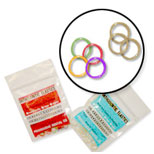 ELASTICS (RUBBER BANDS)
ELASTICS (RUBBER BANDS)
Wearing elastics (or rubber bands) improves the fit of your upper and lower teeth. Wear rubber bands as instructed, and remember that the rubber bands work only if they're worn as prescribed. Failure to wear the elastics will delay treatment.
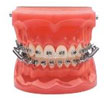 FORSUS™
FORSUS™
The Forsus Fatigue Resistant Device is an alternative to elastics which promotes growth in adolescents, helping to eliminate excessive overbites, improve the fit of teeth, and possibly prevent the need for jaw surgery. Dr. Hertzberg will only use this appliance when compliance with elastics has been a problem.
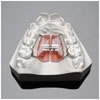 PALATAL EXPANDER
PALATAL EXPANDER
This is one of the most common types of appliances used, especially in Phase I treatments. The palatal expander "expands" (or widens) your upper jaw by putting gentle pressure on your upper molars each time a turn is made. Dr. Hertzberg will instruct you about when and how to turn your expander. It is usually done twice a day (usually right before bed) for about 2 weeks on average, but each one will have a specific number of turns. When you achieve the desired expansion, you will wear the appliance for about 3 months to stabilize the expansion. A removable retainer will be then used after the hold the corrections. There are also other types of expanders that are used to treat specific problems.
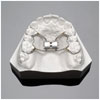 This is the classic type of expander Dr. Hertzberg uses called a Hass expander. It is designed to get pure skeletal expansion.
This is the classic type of expander Dr. Hertzberg uses called a Hass expander. It is designed to get pure skeletal expansion.
This a slightly different kind called a Hyrax. The only difference is there is no acrylic in the roof of the mouth. This is used when the expander needs to be in for longer period of time (such as maxillary protraction cases using a facemask)
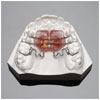
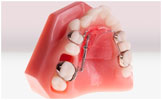
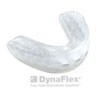 This is a specialized expander known as a Pendex. This is used to move molars backwards with the springs that are attached to the molars.
This is a specialized expander known as a Pendex. This is used to move molars backwards with the springs that are attached to the molars.
This is known as a Distal Jet, which has the same goal of the Pendex, but can move the molars a much greater distance using springs.
POSITIONERS
Positioners complete the final tooth movements in your orthodontic treatment. They are used in cases where stability of the final bite has been a problem or when minor movements are still needed. With good cooperation, you should only need to wear the positioner appliance for about 6 months.
RETAINERS
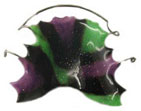 Retainers may be removable or fixed. They hold your teeth in their new, correct positions after your teeth have been straightened. Your orthodontist will instruct you on how to care for your retainer and about the duration of the wear. Wearing your retainer as directed is crucial to prevent regression of your treatment.
Retainers may be removable or fixed. They hold your teeth in their new, correct positions after your teeth have been straightened. Your orthodontist will instruct you on how to care for your retainer and about the duration of the wear. Wearing your retainer as directed is crucial to prevent regression of your treatment.
SEPARATORS OR SPACERS
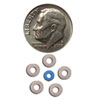 Separators are tiny rubber bands that are placed between your teeth to push them apart so that orthodontic bands may be placed during your next appointment. The separators will be removed before we place the bands. Separators will come out with sticky foods, toothpicks, or floss. They are also sometimes used during treatment to help molars that might be coming in at the wrong angle.
Separators are tiny rubber bands that are placed between your teeth to push them apart so that orthodontic bands may be placed during your next appointment. The separators will be removed before we place the bands. Separators will come out with sticky foods, toothpicks, or floss. They are also sometimes used during treatment to help molars that might be coming in at the wrong angle.
REVERSE PULL FACEMASK
 These are used where correcting underbites (Class III) problems. The purpose of the appliance is to move the upper jaw forward using the chin and forehead as an anchor. The rubber bands will connect to an expander in the mouth. It is only worn at home during any quiet activities and sleeping. Correction usually takes about 6-9 months depending on the severity of the starting problem.
These are used where correcting underbites (Class III) problems. The purpose of the appliance is to move the upper jaw forward using the chin and forehead as an anchor. The rubber bands will connect to an expander in the mouth. It is only worn at home during any quiet activities and sleeping. Correction usually takes about 6-9 months depending on the severity of the starting problem.
Eating with Braces
The first few days with orthodontic appliances will be the most challenging, as teeth are often sore and appliances may feel cumbersome. Think of it like breaking in a new pair of shoes. In many cases it will be difficult to chew due to the upper and lower braces making contact with each other. All of this will improve over the first few weeks of treatment as you get used to the appliances. It is very important not to eat anything hard, crunchy, sticky, or chewy. Braces and many appliances are held on by a very thin layer of glue, and special care is required not to break them off. Eating certain foods will break or cause damage to the appliances which will cause treatment time to be longer.
General Soreness
When you get your braces on, you may feel general soreness in your mouth and teeth may be tender to biting pressures for three to five days. This can be relieved using Motrin or Tylenol. The lips, cheeks, and tongue may also become irritated for one to two weeks as they toughen and become accustomed to the surface of the braces. You can put wax on the braces to lessen this, but try and get used to the appliances as much as possible. The teeth might feel slightly loose as well, which is totally normal
Loose Wire or Band
Don't be alarmed if a wire, bracket or band comes loose. This happens occasionally and is not an emergency. If a wire protrudes and is irritating, use a blunt instrument (the back of a spoon or the eraser end of a pencil) and carefully, gently push the irritating wire under the archwire to try to get it out of the way. If irritation to the lips or mouth continues, place wax or wet cotton on the wire to reduce the annoyance. Call our office as soon as possible for an appointment to check and repair the appliances since we will need extra time. If any piece comes off, save it and bring it with you to the office.
Brushing
It's more important than ever to brush and floss regularly when you have braces so the teeth and gums are healthy after orthodontic treatment. Patients who do not keep their teeth clean may require more frequent visits to the dentist for a professional cleaning. Adults who have a history of gum disease should also see a periodontist during orthodontic treatment. Make sure to keep the regular 6 months cleaning appointments with the dentist!!
Athletics
If you play sports, it's important that you consult us for special precautions. A protective mouthguard is advised for playing contact sports. In case of any accident involving the face, check your mouth and the appliances immediately. If there is any hard contact where the teeth feel loose call your general dentist immediately. If the appliances are damaged call the office to schedule an appointment. In the meantime, treat your discomfort as you would treat any general soreness.
True orthodontic emergencies are very rare, but when they do,we have an emergency line to reach us after hours. As a general rule, you should call the office when you experience severe pain or when you have a painful appliance problem that you can't take care of yourself. We'll be able to schedule an appointment to resolve the problem.
You might be surprised to learn that you may be able to temporarily solve many problems yourself until you schedule an appointment with our office. When working with your appliances, you need to know the names of the parts of your appliances so you are able to identify what part is broken or out of place. After alleviating your discomfort, it is very important that you still call our office as soon as possible to schedule a time to repair the problem. Allowing your appliance to remain damaged for an extended period of time may result in disruptions in your treatment plan.
Poking Wire
Using a pencil eraser, push the poking wire down or place wax on it to alleviate the discomfort. The wax is a short term fix and will cover the area to make it less sharp.
Loose bracket or band
If your bracket or band is still attached to the wire, you should leave it in place and put wax on it. The ties will hold it on the wire in most cases and is generally just annoying and not an immediate emergency. If the wire or bracket comes out entirely please save it and bring it back to the next appointment. If an appliance like an expander or space maintainer come loose, try to avoid pulling on the still attached side.
Loose wire
Using a tweezer, try to put your wire back into place into any of the slots on the bands in the back just so it’s not poky. If trying this and using wax doesn't help, as a last resort use a small fingernail clipper to clip the wire behind the last tooth to which it is securely fastened. If your discomfort continues, place wax on it.
General Soreness
When you first get your braces on, you may feel general soreness in your mouth and teeth may be tender to biting pressures for a few days. Placing Orabase or any topical anesthetic on the affected area may help; this can be found in a pharmacy. If the tenderness is severe, take whatever you normally take for headache or similar pain (Motrin or Tylenol tend to work the best). The lips, cheeks and tongue may also become irritated for one to two weeks as they develop extra tissue and become accustomed to the surface of the braces.